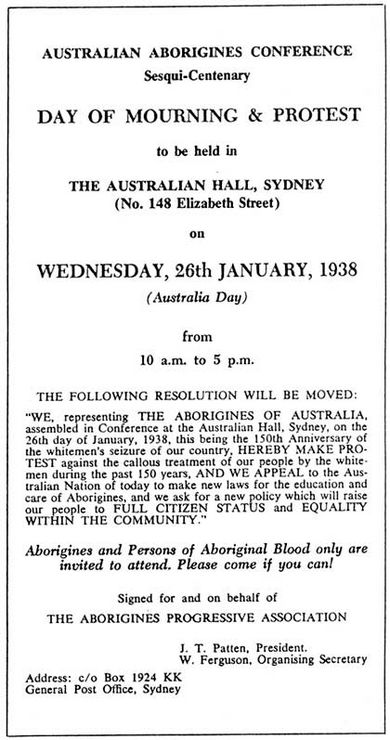Day of Mourning (Australia) facts for kids
The Day of Mourning was a special protest held by Aboriginal people on 26 January 1938. This date was important because it was 150 years since the British first arrived and started to take over Australia.
Aboriginal leaders planned this protest to show how upset they were about 150 years of unfair treatment. They also wanted to highlight how their land had been taken. They chose to hold it on the same day as the Australia Day celebrations, which were mostly for the European population. This protest became a tradition, and similar Days of Mourning have been held every year since.
Contents
Who Organized the Protest?
The Day of Mourning protest was put together by two main groups. One was the Aborigines Progressive Association (APA), based in New South Wales. Its leaders were Jack Patten and William Ferguson. The other group was the Australian Aborigines' League (AAL) from Victoria, led by William Cooper.
These groups had tried to get the Australian and British governments to listen to them before. In the early 1930s, they sent petitions asking for civil rights for Aboriginal people. This included having Aboriginal people in the Parliament of Australia. But their requests were ignored.
In 1888, 100 years after the British arrived, Aboriginal leaders simply refused to join the Australia Day celebrations. But the news media didn't pay much attention. So, for the 150-year anniversary, they planned a bigger event that the media and governments couldn't ignore.
Meeting with the Prime Minister
Even though the government had ignored their earlier requests, the Prime Minister, Joseph Lyons, agreed to meet with the Day of Mourning leaders. This meeting happened on 25 January, the day before the protest. No other government officials or reporters were allowed in. Some news reports at the time suggested that the Prime Minister was more interested in meeting Pastor Doug Nicholls, who was a famous Australian rules football player, than in serious talks.
The Day of Mourning Event
The protest started with a march through the streets of Sydney. Both Aboriginal people and their supporters joined in. The march began at the Sydney Town Hall and ended at the main event of the day: the Day of Mourning Congress. This was a special political meeting just for Aboriginal people. Many important Aboriginal leaders attended, including Pearl Gibbs and Margaret Tucker.
The protesters had hoped to hold their meeting inside the Sydney Town Hall, but they were not allowed. Instead, they met at the nearby Australian Hall on Elizabeth Street. They were even told they had to use the back door, not the front.
About 100 Aboriginal people attended the Congress. This made it one of the first large gatherings for Aboriginal civil rights. At the meeting, the APA and AAL handed out a special document called Aborigines Claim Citizens' Rights. This document was written by Jack Patten and William Ferguson. It began by saying that "This festival of 150 years' so-called 'progress' in Australia commemorates also 150 years of misery and degradation imposed on the original native inhabitants by white invaders of this country."
At the Congress, everyone agreed on an important statement:
WE, representing THE ABORIGINES OF AUSTRALIA, assembled in Conference at the Australian Hall, Sydney, on the 26th day of January, 1938, this being the 150th anniversary of the whitemen's seizure of our country, HEREBY MAKE PROTEST against the callous treatment of our people by the white men in the past 150 years, AND WE APPEAL to the Australian Nation to make new laws for the education and care of Aborigines, and for a new policy which will raise our people to FULL CITIZEN STATUS and EQUALITY WITHIN THE COMMUNITY.
This statement showed their strong desire for new laws to help Aboriginal people. They wanted better education and care, and they wanted to be treated as full and equal citizens in Australia.
Official Australia Day Celebrations
To celebrate Australia Day, the Government of New South Wales planned to act out the arrival of the First Fleet in Port Jackson. They wanted Aboriginal people to take part, but all the Aboriginal groups in Sydney refused.
So, the Government brought a group of Aboriginal men from a special reserve in western New South Wales to Sydney. These men were kept overnight in the stables at the police station in Redfern. On Australia Day, they were taken to a beach at Farm Cove. There, they were told to run up the beach, to make it look like they were running away in fear from the British ships.
The Day of Mourning protesters strongly criticized these reenactments. They were not even allowed to visit the men from the reserve while they were staying in Redfern. However, the Sydney news media mostly focused on the fact that convicts were not included in the reenactment.
Continuing the Tradition
Day of Mourning protests have continued to be held on Australia Day every year since 1938. In more recent times, other events like National Sorry Day (on 26 May) and counter-protests on 26 January, such as Invasion Day and Survival Day, have also become very important in Australia.
In 1998, a special reenactment of the first Day of Mourning was held to celebrate its 60th anniversary. About 400 protesters marched quietly along the same path as the original march. The grandchildren and great-grandchildren of the original protesters read out their ancestors' speeches. The ten main complaints from the 1938 Congress were repeated.
This reenactment was also part of a campaign to protect the Australian Hall, where the 1938 Congress took place. The Government of New South Wales had put a protection order on the building. However, parts of the order allowed everything but the front of the building to be knocked down. Luckily, the building is now fully protected forever.
Images for kids



